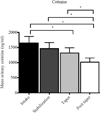Spontaneous reductions in smoking during double-blind buprenorphine detoxification
- PMID: 24845165
- PMCID: PMC4083850
- DOI: 10.1016/j.addbeh.2014.04.023
Spontaneous reductions in smoking during double-blind buprenorphine detoxification
Abstract
Objective: Evidence suggests a positive association between administration of psychoactive drugs and rates of cigarette smoking. Prevalence of smoking among opioid-dependent individuals, for example, is four times greater than the general population. We recently completed a randomized double-blind trial evaluating outpatient buprenorphine taper for prescription opioid (PO) abusers, which provided a unique opportunity to examine naturalistic changes in smoking among participants who detoxified without resumption of illicit opioid use.
Method: Participants received no smoking-cessation services and were not encouraged to alter their smoking in any way. A subset of 10 opioid-dependent smokers, who were randomized to receive the same 4-week buprenorphine taper and successfully completed detoxification, were included in the present study. They provided staff-observed urine specimens thrice-weekly throughout the 12-week trial. Specimens were analyzed on-site via enzyme-multiplied immunoassay for urinary cotinine, a metabolite of nicotine that provides a sensitive biochemical measure of smoking status.
Results: Mean cotinine levels were significantly different across study phases, with significantly lower cotinine levels during taper (1317.5 ng/ml) and post-taper (1015.8 ng/ml) vs. intake (1648.5 ng/ml) phases (p''s<.05). Overall, mean cotinine levels decreased by 38% between intake and end-of-study, reflecting a reduction of approximately eight cigarettes per day.
Conclusions: These data provide additional evidence that opioids influence smoking and extend prior findings to include primary PO abusers, rigorous double-blind opioid dosing conditions and urinary cotinine. These results also suggest that, while likely insufficient for complete cessation, patients who successfully taper from opioids may also experience concurrent reductions in smoking and thus may be ideal candidates for smoking cessation services.
Keywords: Buprenorphine; Cigarettes; Detoxification; Opioid; Smoking.
Copyright © 2014 Elsevier Ltd. All rights reserved.
Conflict of interest statement
All other authors declare no conflicts of interest.
Figures


References
-
- Bigelow GE, Stitzer ML, Griffiths RR, Liebson IA. Human methadone detoxification: Opioid self-administration behavior and withdrawal signs and symptoms as a function of progressive dose reductions. Federation Proceedings. 1981;40:296.
-
- Blum K, Braverman ER. Reward deficiency syndrome: A biogenetic model for the diagnosis and treatment of impulsive, addictive, and compulsive behaviors. Journal of Psychoactive Drugs. 2003;32:S1–S112. - PubMed
-
- Blum K, Cull JG, Braverman ER, Comings DE. Reward deficiency syndrome. American Scientist. 1996;84:132–145.
Publication types
MeSH terms
Substances
Grants and funding
LinkOut - more resources
Full Text Sources
Other Literature Sources
Medical

